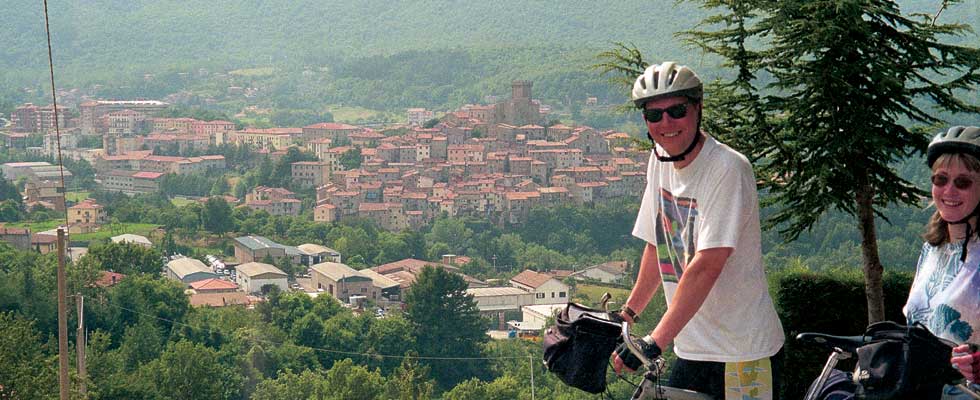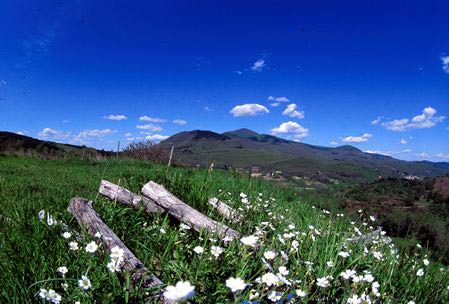
| Weather forecast | Web cam | Weather station | Contact us | Photo Gallery | Links | Search |
| Getting there | Nature | Culture | Epicurean living | Activities | Routes | Our hotel |
Actvities on Monte Amiata

( Monte Amiata from Parco Faunistico)
Mount Amiata, the only volcano in Tuscany, shows its unmistakable outline also when watch from distance. A neat, sharp outline. An island that seems to be floating across a sea of gentle hills. Surrounded by the most classic landscapes of the Maremma and the Sienese area, Amiata, over thousand of years, has been a different place from the surrounding lands. Its luxuriant forests and strangely shaped rocks, its springs and mines have made the inhabitants who live on the top of it proudly different. Like on an island, the waves of history have lapped Amiata across century. Neither the Etruscans nor the Romans, nor the Longobards, nor the western emperors, nor Florence nor Siena did ever succeed in damaging the mountain's spirit, nature and magic. Mr. Ernesto Balducci, a renowned son of this mountain, says about Amiata: "a wonderful casket keeping memories thousands years ols and taking their roots into a stream of lava erupted hundred thousands years ago". These are words carrying a precious hint. On the volcano, nature and history are closely interwined. Trees and monuments, as well as water, villages, rocks and roads tell the same story.
Monte Amiata
Mount Amiata, an ancient and mysterious volcano, was the holly mountain of the Etruscans. It was rich and glorious between the VIII th and XII th centuries, thanks the power of the Abbey of San Salvatore, built to control the Via Francigena. All the villages were built during the Middle Age, and they are today as well conserved as in the past. Probably, we see all around us the same landscape and the same buildings that a medieval countryman could admire in the year 1000.
In the last centuries the territory was not touched by the industrial and economic development, except for the creation of the cinnabar mines which were opened at the end of the XIX th century. What in the past was a cause for solitude and loneliness is today the reason why this land is an unpolluted and a uncontaminated one, in the environmental as in the social issue, ready to be offered to the visitor as an historical and naturalistic place suitable to the most variegated activities.
In the land it’s possible to admire a great variety of plants and landscape: under the 1000 mt of height, the beeches all around the peak of the mountain create a green crown and gives to the mountain its look of gigantic cone, the real lung of Tuscany; going down, the chestnut trees, source of food for centuries and centuries, that are still today precious for the gifts they offer to those fond of chic gastronomically products. Finally, the historic “borghi”, all around the cone at the height of 600-800 mt, grew up where the springs of water gushed out.
At a lower level, the hills of Val D’Orcia and Maremma: the realm of olive trees and of the vineyards of Montecucco, Montalcino, Scansano and Montepulciano.
The reason why our guests visit this land are various: nature, the paths for hiking, those for the mountain bike, the parks, the naturalistic areas, the plants, the flowers (the marvellous spontaneous orchids, for instance), the animals.
The spas, the medieval villages, the churches, the museums and the castles are all of extraordinary interest.
But the queen of the land is surely the cuisine. Very rich and motley, it is a traditional one, but rediscovered and reinvented in the last few years, thanks to the care and passion used in making the most refined and exquisite products of the land: oil, chestnuts, mushrooms, truffles, wines. It’s possible to taste them in the territory’s feasts of the food: the “sagre” as well as the very important event of the Food Festival in Tuscany (Amiata a Tavola), born in 1987 thanks to the gourmet Gianni Bonacina, and still today alive and profitable.
The Chestnuts.
The most important food of the land is, naturally, the chestnut. “Wood bread and clouds’ wine” was the adagio of our grandparents, for the chestnut was their only food until the Second World War. The Fall is of course the season of the chestnut, and it appears gracefully on the whole Amiata’s tables. There are many varieties of chestnuts, but just three of them were scheduled in 2002 for the IGP Castagna del Monte Amiata brand, the Marrone, the Cecio, the Bastarda Rossa. Once dried, the chestnuts produce a flour, used for a manifold variety of recipes, for pastes and cakes.
The Mushrooms.
For the mushrooms too is waited an identification quality brand. The most important is the porcino (boletus edulis), but the territory is full of species and the association of local experts is one of the most important in the region.
The olive oil.
Under the 700 mt, the olive trees. The oil is one of the most ancient productions of the land. We’ve got documents of the IX century about this plant. It found on Amiata an ideal environment. The most important quality is called “Olivastra Seggianese”. You can visit here traditional oil mills, with stone mills, as well as innovative ones, addicted to high quality production.
The cottage and old cheese.
Then, we have the cheeses. Land of shepherds, the Amiata is specialized in producing great pecorino cheeses, with different and particolar way of season and ripeness. Also the honey is a traditional product of our land. Finally, the breads and the cakes: the traditional Biscotto Salato di Roccalbergna (a sort of Bretzl), the various kinds of bread and panini, the panettone, the panforte, the polendina, made with the greatest care by little but wise factories.
With all these foods together – and with the hand made pasta and the smelling roast meats - you can combine the most rare and exquisite recipes, in both a traditional and innovative cuisine.
You have easily an idea of this tradition in a territory so uncontaminated by the great crowds of tourists and where hospitality is still an ancient, unbreakable law.